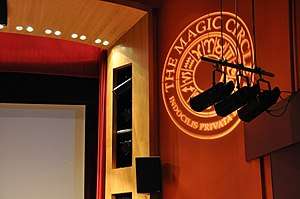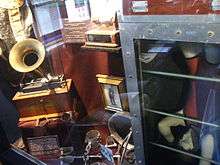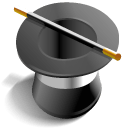The Magic Circle (organisation)
The Magic Circle is a British organisation dedicated to promoting and advancing the art of magic.
 The Magic Circle Theatre | |
| Motto | Indocilis Privata Loqui ("not apt to disclose secrets") |
|---|---|
| Formation | 1905 |
| Purpose | To promote and advance the art of magic |
| Headquarters | Euston London, NW1 United Kingdom |
| Coordinates | 51°31′35″N 0°08′08″W |
Membership | ~1,450 |
Official language | English |
President | Noel Britten |
Main organ | The Magic Circular |
| Website | themagiccircle.co.uk |
Applicants must qualify for membership, either through a performance exam or by a written thesis on a branch of magic, after which they will be designated Member of the Magic Circle (M.M.C.). Further distinctions may earn them the title Associate of the Inner Magic Circle (A.I.M.C.), and Member of The Inner Magic Circle (M.I.M.C), a select group limited to 300 members. The Circle was founded in 1905, and was male-only until 1991. There is a junior branch, the Young Magicians Club.
History


The Magic Circle was founded in 1905 after a meeting of 23 amateur and professional magicians at London's Pinoli's Restaurant. At this founders meeting, chaired by Servais Le Roy, those present decided upon the name of the Society: it was initially felt that the name of the Society should be the Martin Chapender Club, in memory of the performer and founding member who had recently died at the age of 25. However, it was finally agreed that the name "Magic Circle", which shares the same initials as those of Martin Chapender, would be more appropriate.[1]
The first official meeting was at the Green Man public house in Soho, but meetings were later in a room at St George's Hall in Langham Place, where David Devant and John Nevil Maskelyne were regularly seen performing.[2]
Devant became the first president of the Magic Circle, and in 1906, Maskelyne edited the first issue of The Magic Circular magazine, a regular feature for members ever since. The Magic Circular claims to be the longest-running regular magic magazine in conjuring history.
The club was male-only until 1991, when more than 75% of members voted to admit women. As of 2010 there were around eighty female members of the Magic Circle, including Paul Daniels' wife, Debbie McGee.[1] In 2014, Megan Knowles-Bacon became the first female officer in the Magic Circle, as well as the youngest person to be elected as an officer; she was elected as secretary.[3]
Motto
The motto of the society is the Latin indocilis privata loqui, which the club claims to mean "not apt to disclose secrets" (lit. "incapable [of] speaking [of] private [things]"). Members give their word not to willfully disclose magic secrets other than to bona fide students of magic. Anyone breaking this or any other rule may be expelled.
Headquarters

Since 1998, the Magic Circle building[4] in central London near Euston Station in Camden has been available for meetings and corporate entertainment. It was voted the UK's Number One Venue in the hospitality industry's Top 20 UK Venues poll 2008.
The Magic Circle's headquarters houses a theatre, library, museum, a dining room, a clubroom and bars. The museum features magic tricks, props, posters, programs, toys, photographs and artefacts related to conjuring history. Items of interest include, Robert Harbin’s original Zig Zag illusion, Chung Ling Soo's robes, an original Sooty with associated Harry Corbett apparatus, sets of props used by television magicians David Nixon and Tommy Cooper, items and a sound recording of Harry Houdini taken from an Edison cylinder, and a set of cups and balls used by HRH Charles, Prince of Wales when he took his Magic Circle exam in 1975.[5] Visits are by arranged tour.[1][6]
Membership
Magicians who wish to join may spend up to two years as an Apprentice before applying for full membership. They need to have known two current members for at least one year and must be at least 18 years old. These two members are then asked to act as sponsors, or referees, on the candidate's application form and propose them as a suitable candidate for membership. Following the receipt and processing of the application, the candidate is invited to an interview with the examinations secretary, usually at the London headquarters. If the candidate proves suitable and sufficiently knowledgeable a performance exam is scheduled or a thesis may be written. The exam takes place in front of a panel of judges, and candidates must demonstrate their skills to members in a rehearsed act.[7]
If a thesis is chosen, it is read by two examiners and a copy is made available in the Magic Circle library. The final stage is by vote by members of the Council, who will approve the candidate as a member. Once the applicant is successful, they are free to call themselves "Members of the Society" and use the letters M.M.C. after their name.
Members of the Magic Circle include: Charles, Prince of Wales, Luis de Matos,[8] Michael Vincent,[9] Dynamo,[10], John Archer,[11], Walter Rolfo,[12] and Stephen Fry.
Members may take a further examination to achieve the degree of Associate of the Inner Magic Circle. The designation A.I.M.C. shows this higher membership. The A.I.M.C. degree can also be attained through thesis, and in rare cases – that is when a candidate gains 18 or higher out of a possible 20 marks in the written exam – examinees taking the M.M.C. exam are awarded the A.I.M.C. degree. Those who attain an A.I.M.C. degree as a result of a performance examination are awarded the A.I.M.C. with silver star.
Within the society, there are a number of members never exceeding three-hundred known as the "Inner Magic Circle". Full membership of the Inner Magic Circle is denoted by the letters M.I.M.C. after the member's name. Membership of the Inner Magic Circle is by call of The Society's President. The M.I.M.C. degree may be awarded with a gold star, to signify that the recipient is a performer of magic (as opposed to e.g. an inventor, historian or noteworthy volunteer for the Society). The honour of a gold star does not necessarily signify the holder's excellence as a performer and not all recipients are performers of excellence.
Members must undertake not to reveal magic secrets to anyone except bona fide magicians, on pain of expulsion.[13]
The Young Magicians Club
The Young Magicians Club[14] is part of the Youth Initiative of the Magic Circle (the other major part being the prestigious Young Magician of the Year Competition) and is a club for magicians between the inclusive ages of 10 and 18 which was founded in 1996. Sponsored by the Magic Circle, members of the Young Magicians Club meet for monthly workshops at the Magic Circle Headquarters, the 'Centre for the Magic Arts' in London.[15] The Young Magicians Club has a current membership of around 200 members.[16]
The Young Magicians Club's principal means of communication among its members is its bi-monthly magazine Secrets. The worldwide membership also communicates through a members-only on-line forum on the Young Magicians Club website.
Membership in The Young Magicians Club requires no interview or exam and is open to all young people interested in magic. There are monthly all-day workshops for members who come from all over the country to take part. Adult members of the Magic Circle take on the responsibility of instructing the members of the Young Magicians Club. Local adult magic clubs will often have a junior magicians club attached to them but The Young Magicians Club is the only such club associated with the Magic Circle. Members of the Young Magicians Club are eligible to join the Magic Circle at a reduced rate when they reach 18, but then they must complete the examination procedure for full membership.
The Young Magicians Club holds their annual one-day convention every October called 'J-Day'. The convention includes lectures and the finals of two competitions with awards, which include the Home Counties Trophy for stage magic, The Mark Leveridge Cup for close-up magic, Kaymar Komedy Cup and the Peter McCahon Award for Originality. In recent years, the celebrity guest lectures have been presented by Derren Brown in 2010, Dynamo in 2011, John Archer in 2012, Marvin Berglas in 2013, Luis De Matos in 2014 and Dave Loosley and Andi Gladwin in 2015.
The popularity of the Harry Potter franchise was one of the key reasons for the organisation's growth this century with membership doubling after the announcement of the first film in 2001.[16]
See also
- Academy of Magical Arts and its headquarters, The Magic Castle
- American Museum of Magic
- List of magic museums
References
- Soteriou, Helen; Brown, Matt (5 May 2010). "Inside The Magic Circle Of London". Londonist. Retrieved 22 January 2010.
- Gladwin, Andi (June 2010). "Magic Circle Magician FAQ".
- "Magic Circle elects Megan Knowles-Bacon as first female officer". Telegraph.co.uk. 7 November 2014. Retrieved 7 November 2014.
- "Welcome to The Magic Circle". The Magic Circle. Retrieved 22 July 2014.
- "Prince Charles performs his first conjuring trick in public to gain his membership to the Magic Circle". Getty Images. Retrieved 10 July 2018.
- "Our Museum". The Magic Circle. Retrieved 12 May 2014.
- "The Magic Circle guide to examinations" (PDF).
- "ionline". ionline. Retrieved 22 March 2018.
- Dawes, Edwin Alfred; Bailey, Michael (1 July 2005). "Circle Without End: The Magic Circle 1905-2005". Jeremy Mills Publishing. Retrieved 22 March 2018 – via Google Books.
- "Dynamo wins Best Entertainment Programme". themagiccircle.co.uk. Retrieved 22 March 2018.
- "Huddersfield Magic Circle to celebrate 60th anniversary". Huddersfield Daily Examiner. 10 June 2009.
- "Il torinese Walter Rolfo nel club dei migliori maghi del mondo". Retrieved 22 March 2018.
- "Our History". themagiccircle.co.uk. Retrieved 19 January 2019.
- "About Us". The Young Magicians Club. Archived from the original on 8 November 2014. Retrieved 22 July 2014.
- Thomson, Ian A. (July 2000). "The Young Magicians Club". MagicWeek. Retrieved 2 January 2013.
- Wallace, Sam; Hall, Macer (27 August 2000). "Harry Potter conjures wave of Magic Circle applications". The Sunday Telegraph. London. Retrieved 19 July 2008.
Further reading
- Tim Hulse, "Magicians fight to make each other vanish", The Independent. 6 September 1998. Retrieved 21 May 2015.
- Sam Wallace and Macer Hall, "Harry Potter conjures wave of Magic Circle applications". The Daily Telegraph, 19 June 2001. Retrieved 1 March 2008.
- 'Now, is that magic?', BBC News, 14 October 2005. Retrieved 1 March 2008.
- Simon O'Hagan, "Secret London: Tricks and treats, The Centre for the Magic Arts", The Independent on Sunday, 15 June 2003. Retrieved via subscription 1 March 2008.
